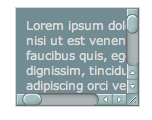Das YUI Team veröffentlicht die produktionsreife Version 3.0 der YUI Bibliotheken (Core, Node, Event, Animation, IO, Drag & Drop und weitere). Version 3 ist eine komplette Überarbeitung (die erste seit 2005) und bringt eine Vielzahl an Verbesserungen mit sich.
YUI 3 is the first ground-up redesign of YUI since 2005, and it brings with it a host of modernizations:
- Selector-driven: YUI 3 is built around one of the lightest, fastest selector engines available, bringing the expressive power of the CSS selector specification into actions that target DOM nodes.
- Syntactically terse: Without polluting the global namespace, YUI 3 supports a more terse coding style in which more can be accomplished with less code.
- Self-completing: YUI 3’s light (6.2KB gzipped) seed file can serve as the starting point for any implementation. As long as this seed file is present on the page, you can load any module in the library on the fly. And all modules brought into the page via the built-in loader are done so via combo-handled, non-blocking HTTP requests. This makes loading the library safe, easy and fast.
- Sandboxed: YUI modules are bound to YUI instances when you use() them; this protects you against changes that might happen later in the page’s lifecycle. (In other words, if someone blows away a module you’re using after you’ve created your YUI instance, your code won’t be affected.)
The code we’re shipping today in 3.0.0 is the same code that drives the new Yahoo! Home Page, and it goes out with confidence that it has been exercised vigorously and at scale. The team is thrilled to be sharing it with you today for the first time in a production-ready release.

